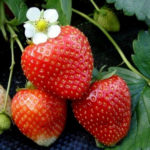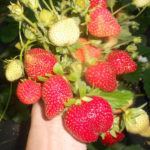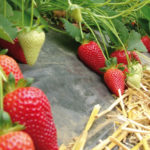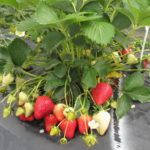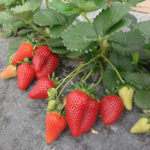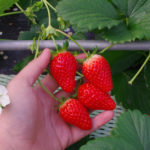Tason grape variety
Tason is an interesting hybrid form of table pink grapes, created by the hands of professional breeders from the All-Russian Research Institute of Viticulture and Winemaking named after V.I. ME AND. Potapenko (Novocherkassk). Arif Muzafarovich Aliev and Taisiya Arsentievna Sonina (Ptah) became its co-authors. In honor of the latter, the novelty was named Tason.
The well-known classic European cultivar was used as a parental form when crossing. Italy, whose flowers were artificially fertilized with the pollen of the Zoreva hybrid, which has in its DNA the genes of the eastern high-quality representatives of the species Vitis vinifera. As a result, the novelty combined the remarkable properties of both ecological-geographical groups, presenting itself to the judgment of grape lovers as one of the best early varieties in aesthetic and gastronomic terms. However, along with these outstanding parameters, the hybrid also inherited negative traits in the form of average fruitfulness of the vines, the need for long pruning of fruit arrows and tedious fragments of barren vines. In addition, the hybrid is not highly resistant to fungal diseases, which is why it requires chemical protection against them.
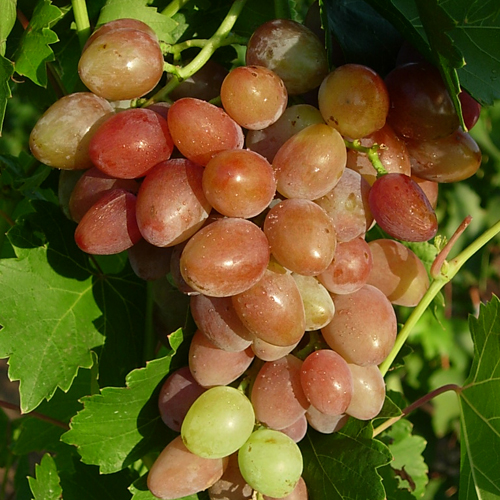
Perhaps, precisely because of the existing shortcomings, the form was removed from the state variety testing in 2009, and did not receive the right to officially be called a variety. But Tason quickly gained popularity among amateurs, and by now it is cultivated on many thousands of plots in various parts of our country. By his example, he shows that even without any bureaucratic procedures, a successful grape variety can win the hearts of a huge number of admirers.
Agrobiological characteristics
Plants show high vigor in the first years after planting. The crown of a young shoot is open, shiny, green in color with a barely noticeable bronze tint in young leaves, without pubescence. Full leaves are large, rounded, and consist of five lobes bending slightly downward. The dissection of the first leaves is insignificant, in the subsequent ones it is rather strong. The upper lateral notches of deeply dissected leaves are closed, with an ovoid lumen. The lower ones are slit-like or V-shaped. Petiole notches are lancet or vaulted with a flat or rounded bottom. Petioles are long, green in color, often with red longitudinal areas. The surface of the leaf blade is reticulate-wrinkled, the teeth along its edge are heterogeneous in size, triangular or saw-shaped, with smooth edges and sharp tops. The flowers of the grapes are bisexual, which allows them not to depend on the vagaries of the weather during pollination, forming full-sized berries without signs of peas. There are different reviews about the maturation of one-year growth. Some winegrowers note the absence of problems in this regard, their opponents claim the opposite. It is possible that the whole thing is in the peculiarities of the climate, and not everywhere the variety shows the same characteristics.
The size of Tason's bunches is large and very large, the shape is cylindrical-conical, the density is moderate. The average weight of a ripe brush is 600-800 grams, some reach a kilogram and more. The combs are long and graceful, yellowish-green in color, often with a pink base. The berries are oval and ovoid, large, 24-25 mm long and 18-19 mm in diameter, very leveled, making the bunches look attractive and neat. The color of the grapes is white-pink, the surface is covered with a thin layer of light prune. The average berry weight is 6-8 grams. The flesh of the grapes is quite dense, crispy when eaten, has a delightfully harmonious taste and a mild nutmeg aroma. Freshly squeezed juice is colorless, has a high sugar content - 19-21 g / 100 ml, with an acid content of 5-6 g / l. The skin of the berries is not too thick, but strong, which, however, does not create problems when chewing.The number of seeds rarely exceeds two, and their presence does not spoil their taste at all. Tasting marks of the variety are deservedly high - 8.2 points.
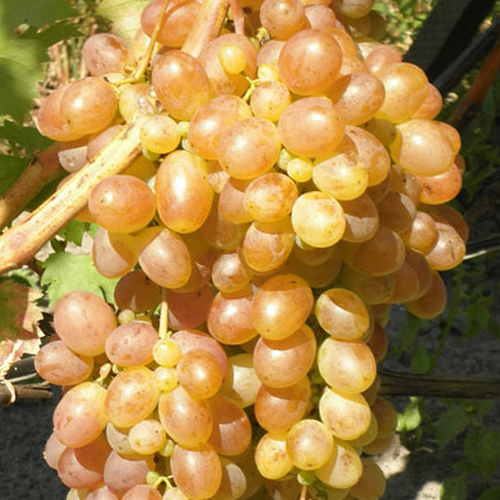
The harvest is excellent for fresh consumption. The beauty of the bunches, as well as the excellent taste and aroma of massive grapes, are appreciated by buyers, and therefore Tason is in high demand in the market. The hybrid is in good standing among farmers, who, in addition to its high commercial qualities, are interested in the early ripening of grapes, which allows it to be sold in a period of low competition and high prices. An important factor for commercial use is its suitability for long-distance transportation, without loss of quality, as well as sufficient keeping quality when stored in refrigerators and cool cellars. On personal farms, our hero will also delight his owners with bountiful harvests, the surplus of which will serve as a wonderful raw material for home canning.
The duration of the growing season from budding to the onset of the removable ripeness of the fruit is 100-110 days for our hero, which characterizes him as a super-early variety. The collection of the first bunches in the south of our country begins already in late July - early August. For a short growing season, bushes, plants require a very small amount of active temperatures - 2150-2250 ° C. A similar level of heat supply is typical for many areas of the middle zone of the country, up to the Moscow region, which are completely unconventional for viticulture, and the ability of a hybrid to ripen there is one of its most important positive qualities. When planting in a harsh climate, it is only necessary to take into account its average frost resistance (-22 ° C), which implies a good shelter of the vine for the winter.
Plant productivity is potentially quite high. With proper care, mature bushes can easily cope with a load of 15-20 kg of grapes. However, for the formation of this volume of the harvest, the winegrower will have to try. Here we should recall the eastern ancestors of Tason, which genetically determined not the highest percentage of fruitful shoots in him - about 55%, and the fruiting coefficient - 1.0-1.1. At the same time, plants react painfully to overloads, reducing the strength of shoot growth, lengthening the ripening of the vine and the harvest, and with regular miscalculations of this kind of bushes, they may even die due to a decrease in the already low frost resistance. For this reason, the annual rational rationing of the load is one of the main conditions for growing this variety.
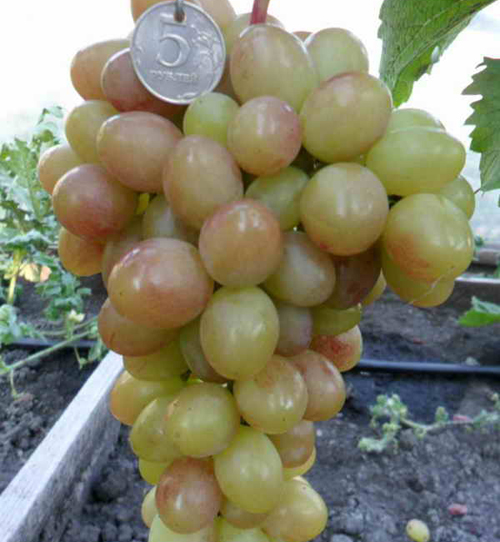
Our hero is one of the record holders in terms of his ability to preserve the freshness of the fruit while the ripe grapes are on the bushes for a long time. Even a month after the onset of removable ripeness, the clusters left hanging on the vine do not rot, and the berries do not grow on them. The ripening crop is not afraid of either rains or changes in soil moisture, since the hybrid does not have a tendency to cracking the fruit either. But you will have to fight with wasps, they really like its sweet aromatic berries.
Agrotechnical features
Economically, Tason can be called neither pampered nor complex-resistant to unfavorable growing conditions. Like most other varieties, this grape is demanding for certain measures to care for it, but at the same time it is not devoid of strengths that greatly facilitate the work of the winegrower.
So, our hero is able to grow on a variety of soils, differing in the level of fertility, mechanical composition, indicators of acidity. To obtain sufficient yields, both rich southern chernozems and not very fertile soils of the Russian Non-Chernozem region are suitable for him.In the latter case, it is only necessary to fertilize the pits well during planting in order to give young plants a supply of nutrients for rapid development in the first years of the growing season. In the south, it doesn't make much difference whether a given hybrid is placed on a slope or plain, as the supply of heat there more than covers his needs. If we are talking about the northernmost territories, where Tason, growing in open ground, faces the risk of an irregular harvest ripening over the years due to the limited SAT level, grapes are planted on the southern slope, and, if possible, in its upper part. On personal plots, a good effect is given by the placement of bushes in a wall culture, on the southern side of any buildings, where they will be protected from cold winds.
The variety is characterized by both excellent compatibility with common rootstock forms and good independent rooting of cuttings. These positive properties determine the absence of difficulties in its reproduction. It should be borne in mind that there is no data on its resistance to the root phylloxera, and therefore, on lands infected with this pest, planting is traditionally carried out with seedlings grafted onto phylloxera-resistant rootstocks, and self-rooted plantings of grapes are laid in regions free of root aphids.
Domestic growers practically everywhere carry out covering cultivation of this form. High-stamped formations are possible only in the extreme south, where, due to mild winters, a small number of eyes on not insulated vines are damaged. In the same place, where frosts exceed the index of -21 ... -22 ° С, removing the vine from the trellis and covering it is a mandatory procedure. To do this, from the first years of life, plants are formed according to stumpless squat patterns, of which the most popular are a multi-arm fan and an inclined cordon.
In the case of Tason, the approach to regulating the load of grapes with shoots and crops should be very responsible. Due to insufficient fertility of the first buds on wintering shoots, spring pruning of plants that have entered fruiting is carried out for a long time, leaving 10-12 buds on the fruit arrows. The total load on the bush of this variety can also be slightly increased compared to the usual one, since only half of the developed shoots are usually productive. Those of them that turn out to be sterile are removed during the fragments, and on the remaining ones, only one fruit cluster is preserved.
Unfortunately, the hybrid is unstable to fungal diseases, in particular to mildew and oidium. However, due to its early maturation period, it often manages to miss outbreaks of these pathogens. Careful protection is required only in the initial stages of the growing season, and especially before and after flowering, when pathogens are especially harmful. During ripening, the berries are protected from wasps and birds by placing the grapes in special protective bags. In this form, they can continue to hang for a very long time without the risk of damage by pests.
